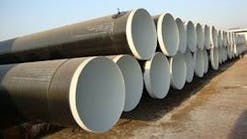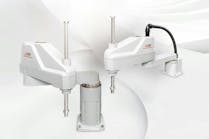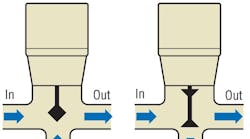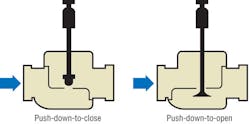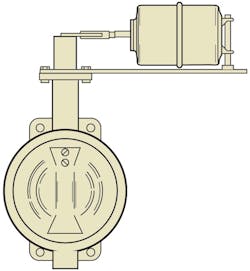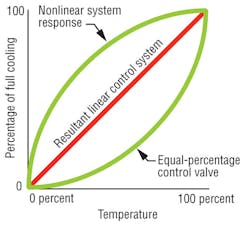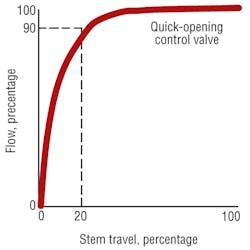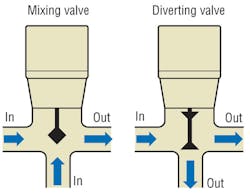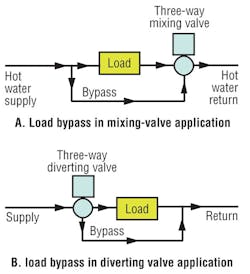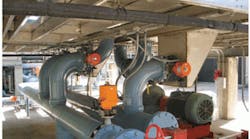When selecting valves for HVAC and hydronic systems, first consider the application requirements and then consider the characteristics necessary to meet those requirements. The following questions provide a guide to correct valve selection:
• What is the piping arrangement and size? The piping arrangement indicates whether a two-way or three-way mixing or diverting valve is needed. The piping size gives some indication of whether the valve requires a screwed-end or a flanged-end connection.
• Does the application require two-position control or proportional control? Does the application require a normally open or normally closed valve? Should the actuator be direct-acting or reverse-acting? Is tight shutoff necessary? What differential pressure must the valve close against? How much actuator closeoff force is required?
Single-seated valves provide tight shutoff, while double-seated valves do not. Double-seated valves are acceptable for use in pressure bypass or inline throttling applications.
The design and flow capacity of a valve determine how much actuator force is required for a given closeoff. Therefore, the valve must be sized before it and the actuator are selected to provide the required closeoff.
• What type of medium is being controlled? What are the temperature and pressure ranges of the medium?
Valves must be compatible with system-media composition, maximum and minimum temperature, and maximum pressure. The temperature and pressure of the medium being controlled should not exceed the maximum temperature and pressure ratings of the valve.
• What is the pressure drop across the valve? Is the pressure drop high enough? The full-open pressure drop across the valve must be high enough to allow the valve to exercise control over its portion of the hydronic system. However, the full-open pressure drop must not exceed the valve’s rating for quiet service and normal life. Closed pressure drop must not exceed valve and actuator closeoff rating.
Globe Valves
Globe valves are popular for HVAC applications. They are available for pipe sizes from 1/2 in. to 12 in. and in a large variety of capacities, flow characteristics, and temperature and pressure capabilities. They provide wide rangeability and tight shutoff for excellent control over a broad range of conditions. Globe valves are made in two-way straight or angle configurations and three-way mixing and diverting designs. Globe valves close against flow and have arrows indicating correct flow direction on their body. Incorrect piping can result in stem oscillations, noise, and high wear.
A two-way globe valve has one inlet port and one outlet port in either a straight-through or angle pattern (Figure 1). The valve can be either push-down-to-close or push-down-to-open.
Pneumatic and electric actuators with linear motion are available to operate globe valves with many control signals.
Ball Valves
Manually or power-operated ball valves are available for two-position applications or modulating applications with direct-coupled electric actuators. Ball valves provide tight closeoff in two-way and three-way configurations. As with all other valves, ball valves must be sized properly to provide good flow control.
When used in modulating service, ball valves must be specifically designed for modulating service as compared with two-position service. Packing must provide leak-free sealing through thousands of cycles to ensure trouble-free HVAC service. The ball and stem should be made of stainless steel or similar material that minimizes sticking to the seat.
Two-way ball valves have equal percentage flow-control characteristics, and flow can be in either direction.
Three-way ball valves can be used in either mixing or diverting service. They have linear flow-control characteristics for constant total flow.
Butterfly Valves
Butterfly valves (Figure 2) control the flow of hot, chilled, or condenser water in two-position or proportional applications. Butterfly valves are available in two-way or three-way configurations. Tight shutoff can be achieved through proper selection of actuator force and body lining. The three-way valve can be used in mixing or diverting applications with flow in any direction. The three-way valve consists of two butterfly valves that mount on a flanged cast-iron tee and are linked to an actuator that opens one valve as it closes the other. Minimum combined capacity of both valves occurs at the half-open position.
When butterfly valves are used for proportional control, they must be applied using conservative pressure drop criteria. If pressure drop approaches the critical level, unbalanced forces on the disc can cause oscillations, poor control, and/or damage to the linkage and actuator, even though the critical flow point is not reached.
Butterfly valves usually are found in larger pipe sizes. For example, two butterfly valves could be piped in a mixing application to control the temperature of the water going back to the condenser. The valves proportion the amount of tower water and condenser-water return that is flowing in the condenser water-supply line.
Two-Way Valves
Two-way valves are available in globe, ball, or butterfly configurations. The combination of valve body and actuator (the valve assembly) determines the valve-stem position. Two-way valves control steam or water in two-position or proportional applications (Figure 3). They provide tight shutoff and are available with quick-opening, linear, or equal-percentage flow characteristics.
Ideally, a control system has a linear response over its entire operating range. The sensitivity of the control to a change in temperature is constant throughout the control range. For example, a small increase in temperature provides a small increase in cooling. A nonlinear system has varying sensitivity. For example, a small increase in temperature can provide a large increase in cooling in one part of the operating range and a small increase in another part of the operating range. To achieve linear control, the combined system performance of the actuator, control valve, and load must be linear. If the system is linear, a linear control valve is appropriate (Figure 4). If the system is not linear, a nonlinear control valve, such as an equal-percentage valve, is appropriate to balance the system so that resultant performance is linear.
Quick-Opening Valves
A quick-opening two-way valve includes only a disc guide and a flat or quick-opening plug. This type of valve is used for two-position control of steam. The pressure drop for a quick-opening two-way valve should be 10 to 20 percent of the piping-system pressure differential, leaving the other 80 to 90 percent for the load and piping connections. Figure 5 shows the relationship of flow vs. stem travel for a quick-opening valve. To achieve 90-percent flow, the stem must open only 20 percent. Linear or equal-percentage valves can be used in lieu of quick-opening valves in two-position control applications, as the only significant positions are fully open and fully closed.
Linear Valves
A linear valve may include a V-port plug or a contoured plug. This type of valve is used for proportional control of steam or chilled water or in applications that do not have wide load variations. Typically in steam or chilled-water applications, changes in flow through the load (e.g., heat exchanger, coil) cause proportional changes in heat output. For example, Figure 6 shows the relationships between heat output, flow, and stem travel given a steam heat exchanger and a linear valve as follows:
• Graph A shows the linear relationship between heat output and flow for the steam heat exchanger. Changes in heat output vary directly with changes in fluid flow.
• Graph B shows the linear relationship between flow and stem travel for the linear control valve. Changes in stem travel vary directly with changes in fluid flow.
Note: As a linear valve just starts to open, a minimum flow occurs because of clearances required to prevent sticking of the valve. Some valves have a modified linear characteristic to reduce this minimum controllable flow. This modified characteristic is similar to an equal-percentage-valve characteristic for the first 5 to 10 percent of stem lift and then follows a linear valve characteristic for the remainder of the stem travel.
• Graph C shows the linear relationship between heat output and stem travel for the combined heat exchanger and linear valve. Changes in heat output are directly proportional to changes in stem travel.
Thus, a linear valve is used in linear applications to provide linear control.
Equal-Percentage Valves
An equal-percentage valve includes a contoured plug or contoured V-port shaped so that similar movements in stem travel at any point in the flow range change the existing flow an equal percentage, regardless of flow rate.
Table 1 presents an example of how an equal-percentage valve would be applied. When a valve with the stem at 30 percent of its total lift and flow of 3.9 gpm opens an additional 10 percent of its full travel, the flow measures 6.2 gpm, or increases 60 percent. If the valve opens an additional 10 percent so the stem is at 50 percent of its full travel, the flow increases another 60 percent and is 9.9 gpm.
An equal-percentage valve is used for proportional control in hot-water applications and is useful in control applications where wide load variations can occur. Typically in hot-water applications, large reductions in flow through the load (e.g., coil) cause small reductions in heat output. An equal-percentage valve is used in these applications to achieve linear control. Figure 7 shows heat-output, flow, and stem-travel relationships for a hot-water coil with 200°F entering water and 50°F entering air and an equal-percentage valve, as follows:
• Graph A shows the nonlinear relationship between heat output and flow for the hot-water coil. A 50-percent reduction in flow causes a 10-percent reduction in heat output. To reduce the heat output by 50 percent, the flow must decrease 90 percent.
• Graph B shows the nonlinear relationship between flow and stem travel for the equal-percentage control valve. To reduce the flow 50 percent, the stem must close 10 percent. If the stem closes 50 percent, the flow reduces 90 percent.
• Graph C shows the relationship between heat output and stem travel for the combined coil and equal-percentage valve. The combined relationship is close to linear. A 10-percent reduction in heat output requires the stem to close 10 percent, a 50-percent reduction in heat output requires the stem to close 50 percent, and a 90-percent reduction in heat output requires the stem to close 90 percent.
The equal-percentage valve compensates for the characteristics of a hot-water application to provide control that is close to linear.
Three-Way Valves
Three-way valves (Figure 8) control the flow of liquids in mixing-or diverting-valve applications (Figure 9).
The internal design of a three-way globe valve enables it to seat against the flow of liquid in the different applications. An arrow cast on the valve body indicates the proper direction of liquid flow. It is important to connect three-way-valve piping correctly; otherwise oscillation, noise, and excessive valve wear can result. Three-way valves typically have linear flow characteristics, although some are equal percentage for flow through the coil with linear flow characteristics for flow through the coil bypass. Ball valves also are available in a three-way configuration, while two butterfly valves can be made to act as a three-way valve.
Mixing Valves
A mixing valve provides two inlet ports and one common outlet port. The valve receives liquids to be mixed from the inlet ports and discharges the liquid through the outlet port . The position of the valve disc determines the mixing proportions of the liquids from the inlet ports (Figure 7).
The close-off pressure in a mixing valve equals the maximum value of the greater inlet pressure minus the minimum value of the downstream pressure.
In globe-mixing-valve applications, the force exerted on the valve disc by unbalanced pressure at the inlets usually remains in the same direction. In cases in which there is a reversal of force, the force changes direction and holds the valve disc off the seat, cushioning it as it closes. If the pressure difference for the system is greater than the pressure ratings of available globe mixing valves, use a ball mixing valve or two butterfly valves in a tee configuration.
Globe mixing valves are not suitable for modulating-diverting-valve applications. If a mixing valve is piped for modulating-diverting service, the inlet pressure slams the disc against the seat when it nears the closed position. This results in loss of control, oscillation, and excessive valve wear and noise. Mixing valves are acceptable using about 80 percent of the closeoff rating, but not recommended, in two-position diverting-valve applications.
Diverting Valves
A globe diverting valve provides one common inlet port and two outlet ports. The diverting valve uses two V-port plugs that seat in opposite directions and against the common inlet flow. The valve receives liquid from one inlet port and discharges the liquid through the outlet ports (Figure 8), depending on the position of the valve disc. If the valve disc is against the bottom seat (stem up), all of the liquid discharges through the side outlet port. If the valve disc is against the top seat (stem down), all the liquid discharges through the bottom outlet port.
The close-off pressure in a diverting valve equals the maximum value of the inlet pressure minus the minimum value of the downstream pressure.
Globe diverting valves must not be used for mixing service. As with mixing valves used for diverting service, media pressure drop across the valve can cause it to slam shut with resulting loss of control.
This file type includes high resolution graphics and schematics when applicable.
The information in this article is excerpted from the Honeywell Engineering Manual of Automatic Control for Commercial Buildings and was provided by the Honeywell Global Field Devices Business. For more information, visit
www.customer.honeywell.com.
